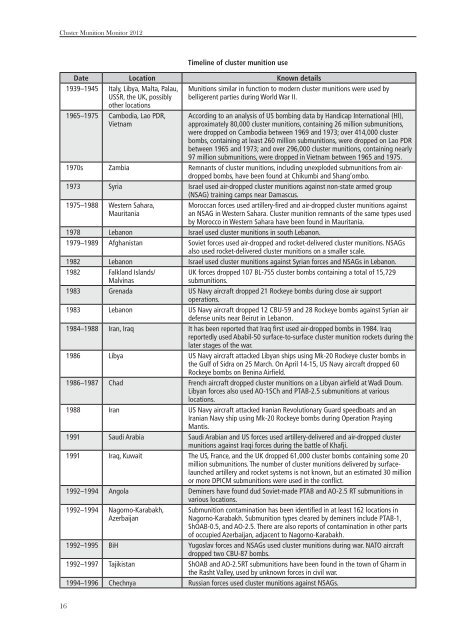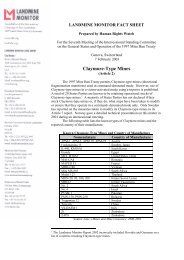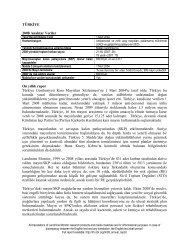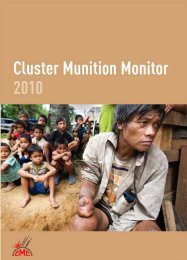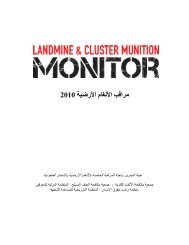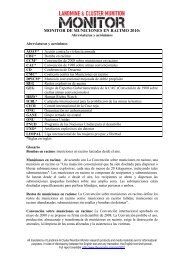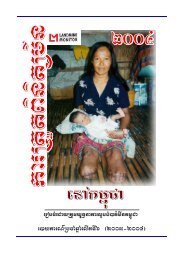Download PDF - Landmine and Cluster Munition Monitor
Download PDF - Landmine and Cluster Munition Monitor
Download PDF - Landmine and Cluster Munition Monitor
You also want an ePaper? Increase the reach of your titles
YUMPU automatically turns print PDFs into web optimized ePapers that Google loves.
<strong>Cluster</strong> <strong>Munition</strong> <strong>Monitor</strong> 2012<br />
Timeline of cluster munition use<br />
Date Location Known details<br />
1939–1945 Italy, Libya, Malta, Palau,<br />
USSR, the UK, possibly<br />
other locations<br />
1965–1975 Cambodia, Lao PDR,<br />
Vietnam<br />
<strong>Munition</strong>s similar in function to modern cluster munitions were used by<br />
belligerent parties during World War II.<br />
According to an analysis of US bombing data by H<strong>and</strong>icap International (HI),<br />
approximately 80,000 cluster munitions, containing 26 million submunitions,<br />
were dropped on Cambodia between 1969 <strong>and</strong> 1973; over 414,000 cluster<br />
bombs, containing at least 260 million submunitions, were dropped on Lao PDR<br />
between 1965 <strong>and</strong> 1973; <strong>and</strong> over 296,000 cluster munitions, containing nearly<br />
97 million submunitions, were dropped in Vietnam between 1965 <strong>and</strong> 1975.<br />
1970s Zambia Remnants of cluster munitions, including unexploded submunitions from airdropped<br />
bombs, have been found at Chikumbi <strong>and</strong> Shang’ombo.<br />
1973 Syria Israel used air-dropped cluster munitions against non-state armed group<br />
(NSAG) training camps near Damascus.<br />
1975–1988 Western Sahara,<br />
Mauritania<br />
Moroccan forces used artillery-fired <strong>and</strong> air-dropped cluster munitions against<br />
an NSAG in Western Sahara. <strong>Cluster</strong> munition remnants of the same types used<br />
by Morocco in Western Sahara have been found in Mauritania.<br />
1978 Lebanon Israel used cluster munitions in south Lebanon.<br />
1979–1989 Afghanistan Soviet forces used air-dropped <strong>and</strong> rocket-delivered cluster munitions. NSAGs<br />
also used rocket-delivered cluster munitions on a smaller scale.<br />
1982 Lebanon Israel used cluster munitions against Syrian forces <strong>and</strong> NSAGs in Lebanon.<br />
1982 Falkl<strong>and</strong> Isl<strong>and</strong>s/<br />
Malvinas<br />
UK forces dropped 107 BL-755 cluster bombs containing a total of 15,729<br />
submunitions.<br />
1983 Grenada US Navy aircraft dropped 21 Rockeye bombs during close air support<br />
operations.<br />
1983 Lebanon US Navy aircraft dropped 12 CBU-59 <strong>and</strong> 28 Rockeye bombs against Syrian air<br />
defense units near Beirut in Lebanon.<br />
1984–1988 Iran, Iraq It has been reported that Iraq first used air-dropped bombs in 1984. Iraq<br />
reportedly used Ababil-50 surface-to-surface cluster munition rockets during the<br />
later stages of the war.<br />
1986 Libya US Navy aircraft attacked Libyan ships using Mk-20 Rockeye cluster bombs in<br />
the Gulf of Sidra on 25 March. On April 14-15, US Navy aircraft dropped 60<br />
Rockeye bombs on Benina Airfield.<br />
1986–1987 Chad French aircraft dropped cluster munitions on a Libyan airfield at Wadi Doum.<br />
Libyan forces also used AO-1SCh <strong>and</strong> PTAB-2.5 submunitions at various<br />
locations.<br />
1988 Iran US Navy aircraft attacked Iranian Revolutionary Guard speedboats <strong>and</strong> an<br />
Iranian Navy ship using Mk-20 Rockeye bombs during Operation Praying<br />
Mantis.<br />
1991 Saudi Arabia Saudi Arabian <strong>and</strong> US forces used artillery-delivered <strong>and</strong> air-dropped cluster<br />
munitions against Iraqi forces during the battle of Khafji.<br />
1991 Iraq, Kuwait The US, France, <strong>and</strong> the UK dropped 61,000 cluster bombs containing some 20<br />
million submunitions. The number of cluster munitions delivered by surfacelaunched<br />
artillery <strong>and</strong> rocket systems is not known, but an estimated 30 million<br />
or more DPICM submunitions were used in the conflict.<br />
1992–1994 Angola Deminers have found dud Soviet-made PTAB <strong>and</strong> AO-2.5 RT submunitions in<br />
various locations.<br />
1992–1994 Nagorno-Karabakh,<br />
Azerbaijan<br />
Submunition contamination has been identified in at least 162 locations in<br />
Nagorno-Karabakh. Submunition types cleared by deminers include PTAB-1,<br />
ShOAB-0.5, <strong>and</strong> AO-2.5. There are also reports of contamination in other parts<br />
of occupied Azerbaijan, adjacent to Nagorno-Karabakh.<br />
1992–1995 BiH Yugoslav forces <strong>and</strong> NSAGs used cluster munitions during war. NATO aircraft<br />
dropped two CBU-87 bombs.<br />
1992–1997 Tajikistan ShOAB <strong>and</strong> AO-2.5RT submunitions have been found in the town of Gharm in<br />
the Rasht Valley, used by unknown forces in civil war.<br />
1994–1996 Chechnya Russian forces used cluster munitions against NSAGs.<br />
16


